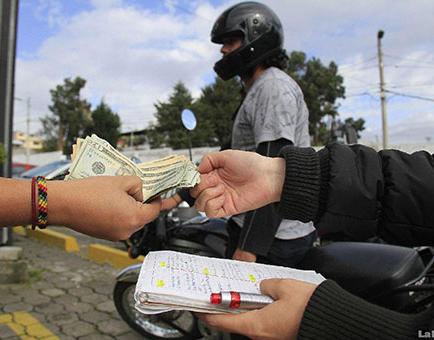Cuenca authorities are currently investigating organizations involved in the business of offering quick loans, but detecting these criminal structures proves to be a challenging task.
The trend of quick loans, a form of usury known as ‘chulco,’ has been on the rise in Cuenca.
During April and May of 2023, police conducted special operations against this crime due to the threats received by debtors who fail to make the so-called “minimum installments.” Although usury is illegal, these loan offers have become more visible, with “instant money” advertisements easily found in neighborhood stores, shops, and social media.
Lenders are no longer limited to markets and popular areas; they have expanded their operations to other commercial areas of the Azuayan capital, even reaching rural parishes, according to police information. Moreover, this illicit business has grown more organized, employing more people to attract clients and facilitate collections.
However, unlike other parts of the country, such as the El Triunfo canton where Los Choneros manage usury, there haven’t been any criminal gangs detected overseeing usury in Azuay.
The origin of the funds fueling these unauthorized loans remains uncertain, but the authorities are actively investigating. Nelson Arroba, the commander of the Azuay Police, describes these activities as “illegal economies” and “dark worlds.” However, concrete evidence supporting these suspicions is still lacking.
William Egas, the chief of the southern district of the Police in Cuenca, leading the operations, explains that they are diligently tracking the cases until they can determine the source of the funds, how they obtain them, and whether they are legal or not.
According to Rodrigo Mendieta, the director of the Economics Research Group at the University of Cuenca, the surge in quick loans is indicative of the substantial illegal economic activities behind them. Usury is often intertwined with other crimes, such as money laundering. In Azuay, historically, the funds handed over by chulqueros have been linked to migrant smuggling.
Moneylenders in rural parishes are frequently associated with migrant smuggling networks and serve as allies to traffickers or “coyotes,” who charge up to $20,000 per trip.
Understanding the source of funds for these loans requires examining other prevalent illegal activities in the province, such as micro-trafficking of drugs and illegal mining, suggests Mendieta.
Criminal groups engaged in micro-trafficking operate with cells in popular sectors of Cuenca, including the Zona de Tolerancia, el Nueve de Octubre, El Arenal, y la Chola Cuencana. These sectors have been identified as having a high presence of these quick loans.
Hard to convict
One of the reasons determining the origin of the funds is difficult is because usury is a crime that receives little investigation. In 2022, the Azuay Prosecutor’s Office received 48 complaints related to usury. Between January and April of this year, they recorded nine complaints. Investigations do not progress when there are no complaints, even if there are detainees.
For instance, on May 17th, the police arrested three individuals with $6,000 and promotional cards for quick loans during an operation at the El Arenal market. However, the Prosecutor’s Office could not validate the arrest due to the absence of a complaint.
In Cuenca, businesses perceive these “drop by drop” loans as a simple way to obtain money rather than a crime. However, when debtors default, threats and assaults ensue, turning easy money into a nightmare. There have been cases where the population has mistakenly lynched collectors, confusing them with extortionists, according to the police chief.
Chulco used by businesses, with exorbitant interest rates
The María Auxiliadora park, located in the center of Cuenca, is one of the areas frequented by chulco lenders. Foreign citizens with cash in hand approach small stores like shops, hairdressers, and stationery shops to offer quick money.
Carmen (name changed for protection) shares her experience of borrowing $200 to purchase products for her business. Initially, it seemed like an easy way to obtain money, with a daily payment of $10 for a month. Collectors would visit her premises daily, with two arriving on motorcycles while one waited outside. They never removed their helmets, and after receiving the money, they promptly left. Carmen complied with the payments to avoid problems.
At the end of the 30-day term, Carmen had paid $100 in interest in a single month. She admits feeling somewhat shortchanged as that money could have been invested further in her business.
Luis Tobar, the director of the Economics Department at the Salesian Polytechnic University in Cuenca, explains that, at first glance, these loans may seem convenient due to immediate financial needs. However, upon calculating the interest rates, the lucrative nature of this business becomes apparent. For instance, a card found by Tobar in a store offered loans of up to $1,000 to be repaid within 24 days. With a loan of $100, the daily payment was $5, resulting in a daily interest rate of 1.34% and an annual interest rate of 487%, compared to the legal financial system’s maximum referential rate of 28%.
In other words, the lender’s intended annual interest rate is 17 times higher than that of the legal financial system. When larger sums of money are involved, the annual interest rate can exceed 1000%. Tobar emphasizes the need for new strategies to integrate the population into the formal financial system. In Ecuador, approximately half of the population lacks access to banking services, including credit facilities.


0 Comments